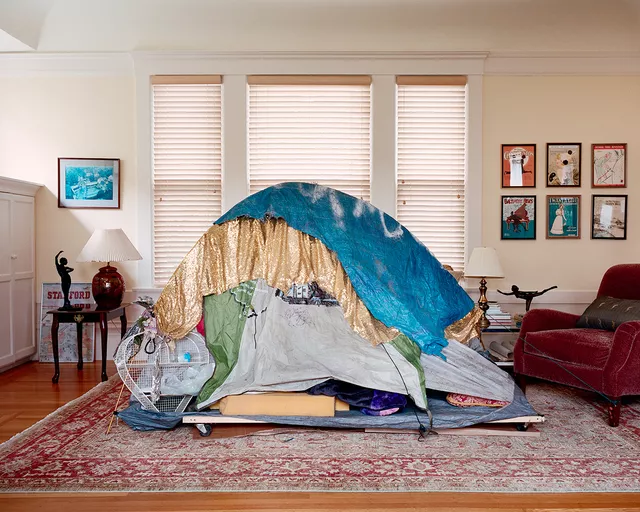NOTES ON HOME: THE UNHOUSED | Larnaca Biennale 2023
- Yev Kravt
- Apr 4, 2023
- 4 min read
We know by now that home is a concept with multiple meanings, but for millions of people across the world, home can also represent a lost memory, or a dream yet to be realised. These are the dislocated, the displaced, the homeless – or perhaps more appropriately, ‘the unhoused’. Writing about homelessness, or on painful memories of displacement, can certainly be a heavy task. It forces us to confront the fragility of belonging and the disorienting effects of dispossession; what feels so secure might not always be here to stay. At the heart of this note – meandering through a series of related artistic projects – lies the question of what happens when home disappears, and only memories remain. If memory itself fades away, are we then left with nothing at all?
The work of Uzbek artist Vyacheslav-Yura Useinov, Shadow of a Non-Existent Home, speaks to this painful question of loss and absence. Useinov spent 11 years reconstructing from memory a view of a courtyard that no longer exists; the courtyard was once overlooked by the home of the artist's close friend, who later emigrated to Canada. Useinov's friend's move, and the demolition of the house that followed are symbolic of a tragic time in which important buildings were destroyed with little regard for history. Meanwhile, the work serves as a metaphor for the simultaneous loss of a common home and a collective identity that was once derived from the Soviet Union.

Vyacheslav-Yura Useinov, Shadow of a Non-Existent Home
Elsewhere, Raida Adon's film, Woman without a Home, is a poignant depiction of the artist's Sisyphean search for identity, an anchor, and a place to call home. Adon's work is deeply rooted in her complex and enigmatic personal biography, reflecting her split identity as a Palestinian-Israeli artist navigating the intertwined yet conflicted societies of the region. Through her art projects, Adon confronts power relations and domination, highlighting the struggles and complexities of living between two nations. Her film depicts her journey through this landscape as she searches for a sense of belonging and a place to call home, only to find that the search itself is often the only constant. The film is testament to the resilience of the human spirit in the face of adversity, and a reminder that even in the absence of a physical home, we can find belonging through invaluable connections with others.

Still form Raida Adon's film, Woman without a Home
Do Ho Suh's Fabric Sculptures are an artistic representation of the homes he has lived in throughout his life. As in the aforementioned work by Useinov, Suh’s sculptures deal with experiences of displacement and migration, pointing specifically to the sense of home that persists despite physical dislocation. His architectural sculptures are rendered at a 1:1 scale, evoking the physical spaces he has inhabited, whilst also transforming the memory of those spaces. The fabric he employs becomes a kind of veil – allowing us to see through, but also reminding us that home is an intangible phenomenon that we carry with us wherever we go.

Do Ho Suh's Fabric Sculptures. Home within a Home.
Conceptualised by Richard Baxter and Katherine Brickell in 2014, “home unmaking” refers to the “precarious process by which material and/or imaginary components of home are unintentionally or deliberately, temporarily or permanently divested, damaged, or even destroyed”. For the researchers, the act of home unmaking co-exists with that of homemaking, highlighting the simultaneity of destruction and creation at the heart of the home. In the 1990s, a radical performance by British artist Michael Landy saw him destroy every single one of his possessions in public. The only thing that remained was an inventory book. However ostentatious, the concept points to the ephemerality of the material – life finds ways to continue in spite of loss.
Where great many artists offer poetic meditations on the issue of lost homes and displacement, others focus their gaze on the issues at the source of the problem. In San Francisco, a city where a crisis of homelessness rubs up against incredible prosperity, accelerated further by the tech industries of Silicon Valley, the German photographic artist Jana Sophia Nolle developed her Living Room series. Reconstructing and shooting makeshift homeless shelters – made from tarpaulins, tents, bags, boxes and supermarket trolleys – in the homes of the wealthy, her work points to the contrast between the haves and the have-nots with a powerful immediacy. There is a performative flourish to the act of installing these shelters in such idyllic contexts, reminding those who are well insulated from hardship that these crippling crises belong to us all.
Jana Sophia Nolle. Living Room, San Francisco.
Artworks like these help us think about that with which we are left in transition, or in the absence of a home. Can we still survive in these conditions? How do we cope with loss, and do memories sustain us sufficiently? Perhaps the answer lies in the resilience of the human spirit and our ability to create new homes and new memories, even in the face of profound challenges. Writing and thinking about homelessness, memory, and displacement – for which the creative process can be a valuable tool – is a call to action to address these issues, aspiring for a more just and equitable world where everyone has a place to call their own.
Links and mentions from the curator’s note:
- Watch the trailer ofWoman without a Home by Raida Adon: https://www.youtube.com/watch?v=EEnD0rms_gA
- Watch the DocumentaryBreaking Down by Micheal Landy: https://www.youtube.com/watch?v=IAJg7rH_EMI








Comments